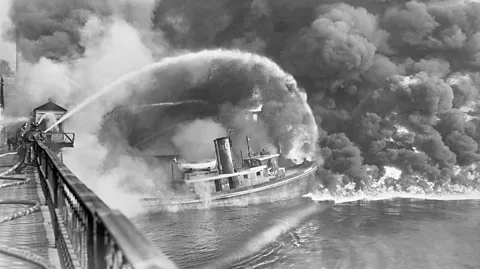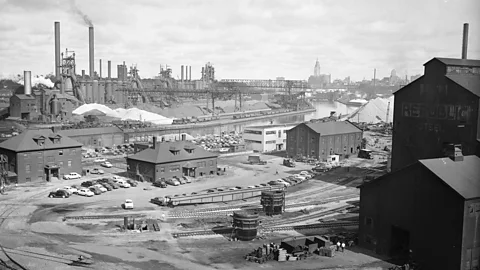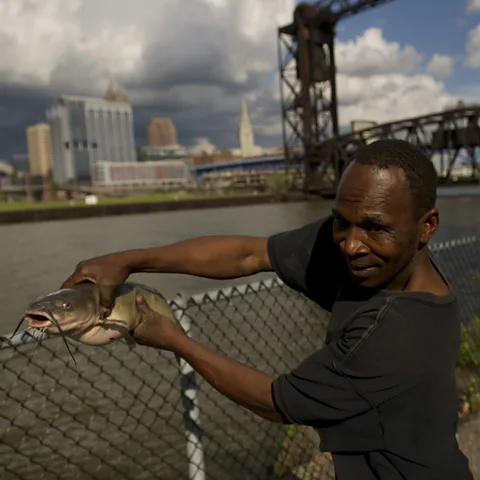'If we can come back from that, we can come back from anything': The burning river that fuelled a US green movement
 Getty Images
Getty ImagesOhio's Cuyahoga River used to be so polluted it regularly went up in flames. Images of one dramatic blaze in 1952 shaped the US's nascent environmental movement, long after the flames went out.
The last time Ohio's Cuyahoga River notably caught fire was 22 June 1969. At midday, debris floating in an oil slick on the river ignited after sparks fell from a nearby passing train. While locals reported the flames reached five stories high, firefighters extinguished them in less than 30 minutes. Two railroad trestles sustained a total of $50,000 in damage ($428,500 in today's money, or £321,000). But the event was over before reporters could arrive.
"All we have photographically of the Cuyahoga fire in '69 is pictures of firemen mopping up, spraying the trestle, and then Carl Stokes, the mayor, on the tracks the next morning talking to the press about it," says David Stradling, professor of history at the University of Cincinnati, US. Earlier images of fires on the same river, such as that pictured above in 1952, nevertheless began to be circulated when the 1969 blaze occurred.
And yet, this short-lived fire on the Cuyahoga River became a powerful moment in the growing environmental activism movement in the United States. The images of the river's previous fires ignited national conversations on pollution and social justice, just as the US's nascent environmental movement was gathering pace.
The history of the river's dire pollution stretches back long before its final blaze. By the late 1800s, Cleveland and the Cuyahoga had become a hub for the Industrial Revolution. Stradling says it started with steel mills towards the head of navigation (the farthest point upstream on a river where boats can travel, often defined by a dam or other physical barrier). The river made it easy for boats to transport ore. "Once the steel industry became established in Cleveland, all these other ancillary industries were good to have nearby," he says.
With all of this steel production came excess chemicals and grease, says Stradling, and since there were virtually no environmental regulations at the time, a lot of it ended up in the river, along with raw sewage.
"We didn't treat our wastewater, so anything that you flushed down the toilet was piped straight into the river," says Adam Schellhammer, Mid-Atlantic regional director of the non-profit, American Rivers. Then, in the early 1900s amid World War One, industrialisation ramped up and the river pollution got worse. "With that uptick in manufacturing, these rivers were bearing the brunt of all that, and there were no restrictions on what went in," says Schellhammer.
By the 1930s, the Cuyahoga had essentially become an open sewer, infamous for its foul smell and telltale sheen of oil slick. Unsurprisingly, the fauna that typically reside in and around the river steered clear, or died. "The Cuyahoga was a completely dead river for decades," says Stradling. "There were no fish, no water fowl." Those who lived nearby cautioned that if you fell in, you had to be rushed to the hospital.
And, occasionally, the massively polluted river burned.
 Getty Images
Getty ImagesThe first fire on the river was in 1868, and there were at least 12 subsequent fires, according to the Environmental Protection Agency (EPA). The biggest ones occurred in 1936, 1941, 1952 and 1969.
Local protests and dogged advocacy by Mayor Carl B. Stokes had already led to a $100m bond for river cleanup passing in 1968 (equivalent to more than $900m today). When the river burned again in 1969, Stokes acted quickly.
"It was a right place, right time situation," says Anne Vogel, former director of the Ohio Environmental Protection Agency and current EPA region 5 administrator. "Cleveland was also a place, at the time, where environmental and social situations intersected."
Stokes was the first black mayor of a major city in the US, and he was acutely aware of how racial inequality in the industrialised parts of Cleveland was reflected in the water pollution issue since poorer, predominantly black communities lived in those areas.
"He's a black man in a majority white city surrounded by almost entirely white suburbs," says Stradling. "So he doesn't have a whole lot of political allies, but he could have allies in the press who can get things before the people and talk about the Cuyahoga as a regional problem, not just Cleveland's problem."
Connecting the social and environmental challenges of the area marks him out as forward-thinking in his work on what came to be called environmental justice, says Stradling. "There's no point in working on public health if you're not going to solve water and air pollution problems."
To drive the point home, Stokes gave a much-photographed pollution tour to reporters the day after the 1969 river fire. The tour went beyond Cleveland's confines to showcase the surrounding area's sewer system. He was making it abundantly clear that in order to clean up the Cuyahoga, the city would need help from its neighbours and the federal government. Convincing the neighbouring suburbs was the real challenge, says Stradling, since they weren't as aware of the pollution accumulating downstream.
On that tour was Betty Klaric, one of the US's earliest specialist environmental reporters, writing for the Cleveland Press, who dedicated much of her career to reporting on the health of the Cuyahoga River and Lake Erie, which the river feeds. Her reporting of the 1969 fire was resurfaced several times by more prominent, national publications.
Stradling recalls a compelling photo of Stokes and reporters standing on a railroad bridge after the fire, its metal distorted from the heat. In the image, Stokes is talking to Klaric. "There are a whole bunch of other press around, including the television [crews] with their cameras, but I just love that that photograph is of him talking to Betty, because I think he knew that she was the most important person besides him on that bridge," he says.
The story reported by Klaric and others was soon picked up nationally. A 1969 Time magazine spread on water pollution reproduced images of the earlier blaze on the river in 1952 – a menacing frontline of flames and black, billowing smoke engulfing a tug boat as it fights to contain a raging fire on the oil-slicked water (the same 1952 image is reproduced at the start of this article). Long, powerful streams of water from firefighters on a nearby bridge cascade over the river, offering backup.
"It was late summer when Time magazine ran a story about water pollution in the United States," says Stradling, who co-wrote Where the River Burned, a history of the infamously polluted Cuyahoga, with his brother Richard Stradling. "[The article] mentioned lots of places, but one that was mentioned most frequently was the Cuyahoga River and how it had become a fire hazard." The book notes that Time did not clarify that the photos of the fire had been taken 17 years prior, and it remains unclear whether the publication "mistakenly used the older photo or did so deliberately, perhaps thinking the more dramatic scene would grab readers' attention". (Time magazine was contacted for clarity on the matter, but did not respond by the time this article was published.)
The photo of the 1952 fire came to symbolise how waterway pollution in the US had grown out of control, and it fed the flames of public outcry over environmental crises. "It was a culmination of events, and the Cuyahoga [fire] was so visible that the calls for unified approaches to environmental protection could not be ignored any longer," says Schellhammer.
 Getty Images
Getty ImagesWhile the first Earth Day, on 22 April 1970, is considered the official start of the environmental movement in the US, the idea had been planted years earlier in 1962 with the release of Rachel Carson's book on the misuse of pesticides, Silent Spring. Eight years later, when 20 million people marched to advocate for nationwide environmental protections, US President Richard Nixon responded by establishing the EPA.
The Cuyahoga River's ongoing recovery
1952: Cuyahoga River's most damaging fire
1969: Cuyahoga River's last major fire
1970: EPA established
1972: Clean Water Act
1986: River otters reintroduced to several Ohio rivers, including the Cuyahoga
1987: Cuyahoga River designated Area of Concern (AOC) under the Great Lakes Water Quality Agreement
2006: Bald eagles return to the Cuyahoga area
2009: Great Lakes Restoration Initiative begun by EPA
2019: Conditions improve enough to lift restrictions on consuming Cuyahoga fish
2020: Brecksville Dam removed
2022: First natural trumpeter swan nest seen on the Cuyahoga
Two years after that, the Clean Water Act followed, which laid the groundwork for the restoration of the Cuyahoga. While not a direct cause and effect, the river fires are often cited as the prime example of water pollution at its worst in the US. The Cuyahoga River in particular, Schellhammer and others note, comes up time and again in this context. But Stradling adds that it was far from alone – as the Clean Water Act was being formulated, most members of Congress named a river in their jurisdiction that needed protection.
What the Clean Water Act did
The Clean Water Act was actually an amendment to the existing Federal Water Pollution Control Act, which was passed in 1948, but the changes to the framework were so significant that it took on a new name.
"It put restrictions and parameters on what could be discharged," says Schellhammer. "There was a set limit. Out of that [came] the Great Lakes Water Quality Agreement, also enacted in 1972, which framed what the entire area needed to do to clean up that river."
Schellhammer says the Clean Water Act also acknowledged the need for wastewater treatment, which was virtually nonexistent before then. One new initiative that stemmed from the Act was connecting more of Cleveland's suburbs to an expanded sewage treatment plant, something Stokes had long argued for.
Then, the industries in the city began to clean up their act. "Mills were already investing in some technologies that would dramatically decrease the amount of problematic effluent that went into the river, so that was really helpful," says Stradling. "A lot of the most problematic industries [like oil refinement] simply closed and left in Cleveland."
The new environmental restrictions played a significant part in shuttering the factories that supported the steel industry in Cleveland. "It [was] this balance of regulatory framework, legal precedence and public outcry," Schellhammer saysof the industrial retreat.
Despite these developments, river cleanup on the Cuyahoga was gradual from the 1970s to the late 1980s. "Water quality definitely improved; we wouldn't call it restored," says Schellhammer.
 Getty Images
Getty ImagesSome of the river's more significant restoration projects have been dam removals.Dams can be major impediments to the health of a river. They act as bottlenecks, limiting fish migration and increasing turbidity. In 2020, the Brecksville Dam, which was initially built to move water into the Ohio and Erie Canals, was taken out.
"It was pretty straightforward, but really awesome to show the benefit of that dam removal, because basically you're connecting the water and fish populations of Lake Erie to more upstream habitats," says Jennifer Grieser, director of natural resources for Cleveland Metroparks and Cuyahoga Area of Concern board member. "We immediately started to see more species recruitment throughout the whole length of the river." The next big project on the docket is the removal of the over 100-year-old Gorge Dam, considered the largest remaining impediment to the Cuyahoga River's health.
Grieser has overseen the removal of five impairments in the Cuyahoga's Area of Concern, including lifting restrictions on consuming fish from the river in 2019, and also the 50-year anniversary of the 1969 fire. She has four left, which she aims to complete within the next five years.
Yet people are already enjoying the cleaner state of the river. It's now considered a water trail, often dappled with kayakers, anglers and birdwatchers hoping to see blue herons or bald eagles, which returned to the area in 2006. The water is not considered pristine yet, but the "crooked river" has come a long way since it caught on fire over half a century ago.
"That's the amazing thing about this restoration story:i t happened in a lifetime," says Grieser.
Today, the US is at another pivotal point for the future health of its natural resources. In March, the Supreme Court weakened the reaches of the Clean Water Act, and the EPA cancelled over 400 grants. "Federal investments played a huge role in why [the Cuyahoga] River is functional again," says Schellhammer. The BBC contacted the EPA for comment but did not receive a response by the time this article was published.
The Cuyahoga may have represented how bad water pollution can get, but it became the ultimate comeback story.
"If we can come back from that, we can come back from anything," says Schellhammer.
--
For essential climate news and hopeful developments to your inbox, sign up to the Future Earth newsletter, while The Essential List delivers a handpicked selection of features and insights twice a week.
